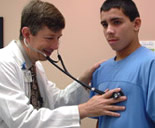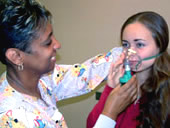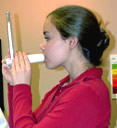Ozone and Your Patients' Health
Clinical Scenarios
 |
 |
 |
 |
Clinical Scenario 1
A 12-year-old girl arrives at your office with her mother for an evaluation of the child's asthma. The mother reports that yesterday her daughter developed chest tightness and shortness of breath at soccer practice. A couple of puffs on her albuterol inhaler relieved the symptoms and allowed her to finish the practice. Rescue medication was needed again after dinner, and the girl woke up during the night and this morning with wheezing and shortness of breath. A mild expiratory wheeze is still perceptible. The mother says generally her daughter has been doing fine since starting a daily regimen of ICS six months ago. There have been only two episodes of wheezing and both of them have been during the nights following soccer practices on Code Red ozone air quality days. The mother asks you, "Do you think ozone caused her wheezing? Should I make her skip practice if it's a Code Red air quality day? Is it safe for her to go out at all on those days?"
Clinical Scenario 2
During the well-child physical exam of a 3-year-old boy, the mother indicates that she is starting back to work and, for four days a week, she will be leaving her son in a local day care. She has a few questions about the day care situation she has found for him. One of the questions concerns outdoor playtime on days with high levels of air pollution. It is the daycare's policy to let the children go out for an hour in the morning on Code Orange or Red air quality days. The mother asks you, "Shouldn't they keep him in on days when air pollution levels are high?"
Clinical Scenario 3
A 32-year-old man comes in to the office with concerns about the exercise program he recently started. After discussing problems with a sore knee, he describes an episode of coughing and chest discomfort - like a burning sensation in the airways - that occurred recently. Although it was a Code Orange day for ozone, he decided to go for a run. Shortly after leaving his home, the man started coughing, so he slowed to a brisk walk. Even at that pace, he felt a burning sensation in his chest made worse by taking a deep breath. So he went home and rested on the couch. In about an hour the pain subsided. He asks you, "Can air pollution cause burning like that?"
A 68 year old patient comes to your office for a routine visit six months following an uncomplicated myocardial infarction. He has just completed cardiac rehabilitation and is asking your advice about his proposed ongoing exercise program. He has experienced no chest pain or shortness of breath since his MI, and his hypertension is controlled. He would like to exercise for 30 minutes on a cycle ergometer on three days per week at a local gym and take a 60 minute outdoor walk on two other days. However, he heard on NPR that the National Research Council has found that more people are likely to die on days when ozone pollution is bad and wonders if there is anything he can do to avoid that risk.
 |
 |
|
